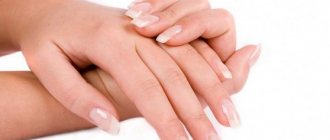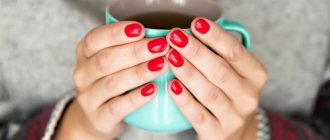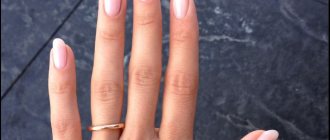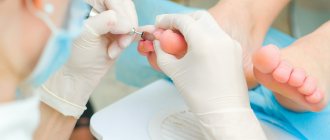Today, many girls for whom the beauty of their hands is important strive to master the basics of manicure art on their own. It’s more difficult for them than for professional craftsmen, because they have to look for answers to many questions on their own. Yes, and for those who have received a diploma as an oil master, sometimes it is not easy to master working with some material.
Currently, a huge number of products are being produced. And technologies from different manufacturers may vary. This is why situations arise when the usual established technique does not bring the results that we would like to expect.
Our article is devoted to one of those issues that cause a lot of controversy in the beauty communities. Do I need to remove the sticky layer from the base? Most professionals answer this question in the negative, but if everything were so clear, disputes would not arise at all.
What is a sticky layer
Many gel materials, which include bases, varnishes, building and strengthening gels, paints for painting and top coats, polymerize in ultraviolet or LED rays and form a sticky layer. Why is this happening? During drying, the substance passes from one state of aggregation to another, and a crystal lattice is formed. The process is accompanied by the release of a dispersion liquid, which is the very stickiness that can be seen on the surface. In some cases, heat is also released - it is because of this that materials are said to be baked in a lamp.
How to remove artificial material correctly and why is it important?
You've probably heard that gel polish spoils your nails, making them thin and brittle. It is a myth! It's not the material that ruins your nails! One of the reasons for damage to the nail plate is improper removal of the artificial coating, so this procedure must be approached with special responsibility!
Is it possible to remove gel polish yourself at home without damaging your nails? What materials and tools are needed for this? Let's figure it out.
How long can you wear gel polish?
First, let's figure out what period of wearing the coating is optimal. Often girls wear gel polish for a month, or even longer. However, they do not understand that they can damage the nail plate.
Technologists advise walking with the coating for no more than 2-3 weeks. Prolonged wear puts stress on the tip of the nail plate, its root suffers from the weight of the coating. All this can lead not only to breakage, but also to deformation of the nail plate.
How can you not remove gel polish?
RULE 1: Under no circumstances should you pick at the gel polish or tear it off the surface of the nail plate, because this can cause serious injury! If you are careless, you can remove the top layer of the nail along with the material, and this can lead to thinning and, at a minimum, painful sensations when in contact with water and various surfaces. RULE 2: do not file away partially peeled off gel polish
In this case, you also risk cutting off the top layer of the nail and ruining it.
RULE 2: do not file away partially peeled off gel polish. In this case, you also risk cutting off the top layer of the nail and ruining it.
What other consequences might arise?
- There is a possibility of tearing not only the gel polish from the nail, but also the nail plate from the nail bed.
- You peel off the artificial coating, and the nail plate becomes thinner and thinner each time.
- Those with thin nails may feel unbearable pain during coating - the base will burn strongly in the lamp. They can also get a burn to the nail plate, which in turn can lead to onycholysis - separation of the nail plate from the nail bed. It will take quite a long time to treat onycholysis.
- You will have to strengthen the nail plate, and this will require additional time for the manicure procedure.
- You will have to buy materials to strengthen the nail plate: acrylic powder, gel or polygel. And these are additional financial expenses.
- Thin nails become mobile and weak, so the coating may be worn less than usual. You will have to try very hard to avoid detachments and chips.
We hope these reasons are enough to convince you not to peel off the coating from the nail plate and do the gel polish removal according to the rules!
By the way, the peeling process itself is quite painful, it’s hardly worth it!
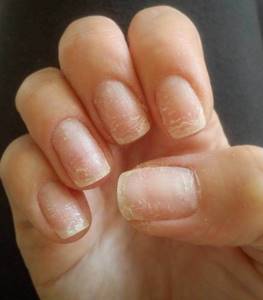
Will there be a sticky layer on the base?
Many people know that there are tops without a sticky layer. But it is unlikely that you will be able to find a base with such a feature on sale.
Why is that? Because in some cases the stickiness of the top interferes with the master. Non-dispersion material is used for complex designs. For example, it is used to color rhinestones and bouillons. Removing stickiness from a non-uniform surface is extremely problematic.
The base is top coated with varnish, gel or top without fail. The craftsman does not have to wipe the material lying in the thin crevices between the rhinestones and opals. Even if the stickiness is not needed, it is quite easy to remove it from the base. Therefore, almost all bases on the market are not without this stickiness. When buying a new material, be sure that after drying you will find stickiness.
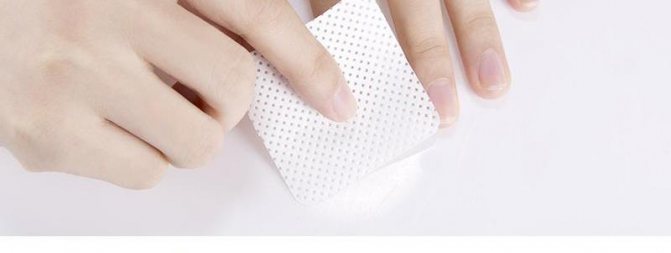
Do I need to remove the sticky layer from the base?
But the dispersion layer is not only a side effect, otherwise manufacturers would have long ago figured out how to get rid of it. The sticky layer also serves to adhere the layers to each other. The coating adheres better when applied to a dispersion substrate. So is it necessary to remove the sticky layer from the base? It turns out that it is an integral part of the right technology.
But we have not yet received an answer to the question of whether it is necessary to remove the sticky layer from the base. It’s too early to draw conclusions. But let us remember that if there are no “aggravating circumstances”, you can simply ignore it. After applying the base and drying it, simply move on to the next step.
Before sawdust
Thick bases are used not only to ensure adhesion between the nail bed and the decorative coating. Using this material you can level the nail plate and even complete the missing corners.
Of course, to get perfect highlights, you need experience, dexterity and theoretical knowledge. For a beginning craftswoman, the result may be the opposite: the base will not level the surface, but, on the contrary, will distort it. Material that is not laid out correctly can form sagging and bumps when baked in a lamp. What to do in this case? Will we really have to do a complete dismantling and start all over again?
Fortunately, the situation can usually be corrected with a file. It is enough to simply polish the tubercles and thickenings well, removing excess volume. But before you pick up the file, you need to remove the sticky layer from the base. Otherwise, you will get dirt and you won’t be able to get the job done quickly. Sanding a sticky surface is a waste of time. Wipe the nail, getting rid of the dispersion layer.
Nails after removal
Recently, manicure using gel polish has become very popular. Thanks to the stable coating that is obtained after applying the gel composition, the nails acquire a durable, beautiful manicure that is resistant to mechanical damage. And although this option for decorating nails is considered safe, after removing this coating, a number of restorative procedures are required. The use of chemicals has a negative impact on the natural layer of the nail plates and skin. After several procedures of using gel polish, nails become thinner, brittle and brittle.
Girls know what their nails look like after removal. These are rough plates that peel and break at the slightest load. To restore the natural strength and beauty of your nails, you need to give them complete rest for a while. This means that for some period you should not even use regular varnish. The best option is wellness treatments, including the use of vitamin complexes and moisturizing oils.

Brittle nails must be cut. Weak plates look unsightly and break with a slight touch. If you want your hands to look well-groomed, it is better to trim the thinned edges and gradually restore their attractive appearance. To ensure professional nail care after removing gel polish, it is recommended to purchase specialized complexes designed for restoration and healing. The substances that make up these products include a lot of useful vitamins and microelements, which, when applied to the nail plates, form a protective film. Thanks to this, nails acquire a healthy and well-groomed appearance after the first use.
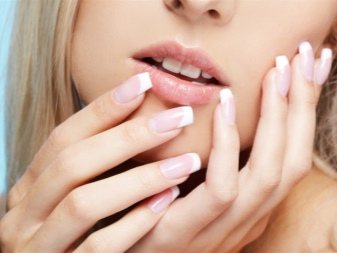
Natural products will bring great benefits for nail health. Along with the use of specialized manicure products, it is necessary to use lemon juice. By rubbing your nail plates with natural juice every day, you will notice how quickly rough nails covered with white spots become healthier and more attractive. Sea salt baths provide a good restorative effect. After removing gel polish, nails, healed with sea salt, acquire strength and attractiveness.
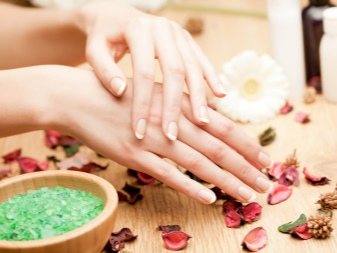
If your nails hurt after removal, do not resort to sanding or other manicure procedures. During the recovery period, it is better not to touch the matte surface of the nail plate, which is gradually covered with a natural keratin layer. After removing the sticky layer of coating, the use of oils will be of great benefit. Fats perfectly restore nail plates from the inside. Therefore, if your nails hurt, be sure to use castor, almond, olive or any other natural vegetable oil. By treating your nails after removing the gel polish with any of them, the natural beauty of the nail plates is quickly restored.
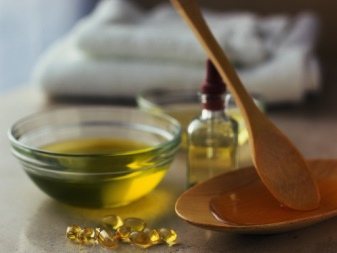
Regular iodine will help quickly restore natural beauty and attractiveness. This procedure will quickly nourish your nails with beneficial substances. In addition to the use of professional vitamin complexes and natural oils, proper nutrition plays a great role in the recovery process. In order for your nails, hair and skin to become healthier, you need to eat dried fruits, dairy products, fish, meat, and vegetables. Freshly squeezed juices bring great benefits to the whole body.
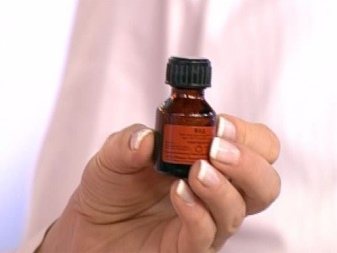
Varnish and base of different brands
Some people believe that it is absolutely forbidden to use products from different brands. But if earlier such an idea was quite common, today most masters claim that this statement is greatly exaggerated.
And yet there is some truth in it. It happens that when using products from different companies, the varnish simply rolls off the base. Before you have time to finish painting your nail, you may notice a bare end or a gap near the cuticle. Let's not argue with the fact that some products are simply categorically incompatible. But in most cases, simply wiping your nails with a clinser is enough.

So, an important point that is also worth remembering: after the base, you need to remove the sticky layer if the varnish and base of different brands do not work well together. As a rule, this trick works well. But it also happens that simple wiping is not enough. Then it’s worth going over a well-dried base with a soft buff. There can be no clear recommendations. Experiment to determine which method works best for your materials.
Facilities
Gel polish has almost eradicated the use of classic nail polish due to its advantages: it makes nails beautiful for a long time - up to 3 weeks, strengthens them, allows them to grow in length and create different designs on the nail plate
The most important thing is that this product is safe and requires only a short time for the procedure, which usually does not take more than 2 hours
After completing the application of gel polish, a sticky layer forms on the surface of the nail, which must be removed using a special liquid - a cleanser. Most women do not know the correct name of a degreaser; let us remind you once again that in professional circles it is called “cleanser”. Its composition is extremely simple: about 70% water, 25-28% alcohol and fragrance for a pleasant aroma. Women often ask why a sticky film forms after applying base, gel polish and top coat. It serves for better adhesion of the layers to each other, which each time lie on top of each other and require fixation in order for the coating to last as long as possible.
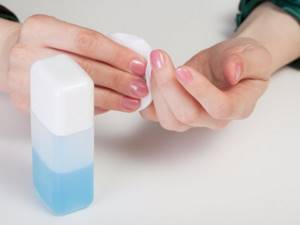
As a rule, professional craftsmen use gel polish and cleaner from the same company - this allows them to use the products rationally and obtain a high-quality coating with a glossy shine and uniform texture. If you choose different brands of varnish and degreaser, you may encounter the problem of color clouding due to the reaction of the chemical elements of the products with each other; In one brand, such an incident is unlikely to happen.
The cleaner is always used in the final stage - removing the sticky layer. Without it, it is impossible to obtain the expected result: a glossy, uniform surface of the nail plate.
This liquid product is used for:
- Removing the sticky layer from the nail. This is its main task, and it is for this that the product was invented.
- Treating the nail plate before applying the base. The nail has an invisible lipid film, which is a consequence of the work of the glands and acts as a barrier against the negative influence of external factors. To create a high-quality coating, it must be removed using a special product - a degreaser or a regular cleaner.
- Sterilization of professional instruments, namely brushes. The liquid consistency of the product allows you to easily remove excess varnish from a brush and other tools such as scissors due to the presence of alcohol in the composition.

How to remove the sticky layer from the base
We looked at some special cases when it is necessary to remove the dispersion layer, and also talked about when this should not be done. If you are faced with a situation in which it is better to get rid of stickiness, you will probably wonder what is the best way to do this.
The ideal option is a special liquid. It is not so expensive that saving on it would be worthwhile, and its consumption is low. A pack of lint-free wipes will also last a long time. These are the best materials for removing stickiness.
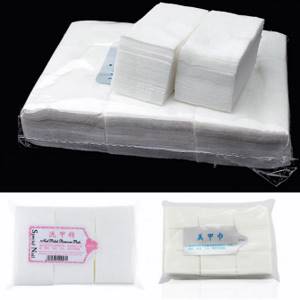
But it happens that the right remedy runs out at the most inopportune moment. You can replace the clinser with alcohol tincture, cologne, and even regular vodka. But in this case, some side effects may appear, for example, clouding of the base, acquisition of a yellowish or gray tint.
You can also wipe your nails with nail polish remover, but you need to do this very quickly to avoid a reaction. If you hesitate, the base may peel off.
How to use a degreaser?
Here are some practical tips on how to use the product correctly:
The degreaser is applied to the nails using a lint-free cloth.
This is important, since a regular cotton pad can leave almost invisible lint, which will affect the quality of adhesion of the material to the nail and, accordingly, its wearability. A little life hack: if you don't have lint-free wipes, you can just dry regular wet wipes and cut them into small pieces! The product is applied to a clean nail plate after removing the natural gloss with a buff or a grinding file (read about the types of files here). After applying the product, it is very important not to touch your nails with your fingers, as they will leave greasy marks (they are invisible, so it is important to know about this) and they will need to be degreased again. If you use a detack remover, it is applied after the final topcoat has polymerized.
What not to do
The main thing to avoid is experimenting on your own hands. If you want to see how materials from different brands will work, practice on tips. Be sure to make a mark on the tip if you think it’s better to remove the stickiness from the base!
Do not use household chemicals or medications to remove stickiness. In general, you should be especially careful with any substitutes for professional products.
Never use cotton pads, sponges, napkins, paper or regular cotton balls to remove stickiness. Any material that leaves lint is detrimental to manicure. In extreme cases, lint-free napkins can be replaced with paper tissues. But working with them is much more difficult.
So, we have found answers to the question of whether it is necessary to remove the sticky layer from the base, when it is worth doing this and when not, and also considered what materials should be used for this.
Significant Aspects
Watch the video carefully to remember the correctness and nuances of the removal procedure.
The success of creating a manicure depends not only on skill, but also on the quality of the products used. Experienced nail industry professionals recommend using all the necessary components from one brand. In this case, it is desirable that the brand be fairly well-known and proven to be the best. The sticky layer of the base should be removed not with cotton pads, but with special lint-free wipes. In this case, you will avoid sticking of small fibers. It’s also worth moistening the napkin well and changing it at least twice.



